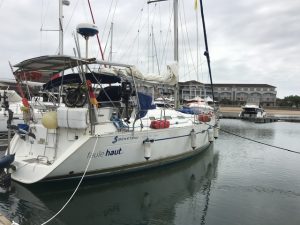
Agulhas Current / Mozambique Channel
Faule Haut almost shattered by a huge wave in 60 knots storm south of Madagascar
DIARY
08.11.2019
Faule Haut is leaving Reunion heading for Cape Town, South Africa via Richard’s Bay (east coast of SA.).
For those who have followed my thread, know, that right now I am in one of the most dangerous sea areas in the world. (If you want to know why, google “Agulhas Current” and “Mozambique Channel”)
Fourteen days before I left Réunion, a group of ten boats left Réunion (among them Warren, an American Skipper that I met at New Zealand and Mauritius) to make this dangerous passage together. They also had contact with a South African guy named Des, who has made this passage seven times already and who gave them weather data and more valuable information and routing advices via email over satellite phones and SSB/HAM radios.. This group was taking the route north of Madagascar, which is considered less dangerous than the straight course south of Madagascar. I would have loved to join them, but I had German friends on my boat when they left Réunion. Another problem for me is the fact that I will pick up one crew (Immanuel) at Cape Town on 03.12.2019. Therefore I could not take the northern course around Madagascar, because that would take me about 14 days longer (1,200 nm longer) to get there. I would be too late in Cape Town. Immanuel has booked the flight to Cape Town already, and also the flight from the Caribbean back home to Germany. So there is no way to change my cruising plan. I don’t want to disappoint that fellow. So that southern approach to South Africa was my only choice.
You find amazing guys among the sailing community, like Des, who has been routing/helping 270 boats to make this passage through this channel within the last four years. Checking the weather daily and sending mails to skippers of all nationalities, just for their safty, free of charge.I am Des’ number 77 that he is helping this year 2019.
Another amazing Swedish couple, Lisa & Oskar (I met them first time in the Caribbean early 2018) on their SY HILMA (SY-HILMA.COM) offered me to use their Iridium satellite phone for free, when we remet at Mauritius a few weeks ago. I jumped on this offer and got me an Iridium SIM Card. Without it, this passage would have been a lot more dangerous than it already is. It is a MUST, to be able to get weather information in order to make it halfway safely. Without it, I would have had to make a passage of about 1,400 nm without any weather data, sailing blind from Réunion to the South African Coast.
Short before I left Réunion I got an email from Skipper Warren, sent from his SY ELIANA, in which he told me, that he has gone through hell (even though he took the „safer“ northern route), not he alone, but as well all the other nine boats of that group he left with.He was talking about waves of 6-8 m hight, breaking over and near the boat and crashing against the hull, and “nearly capsizing boats”. So this report at first hand was proof to me, that the stories on the internet about this passage are no fables.
With this outlook I left Réunion scared.
14.11.2019
In the morning at 10:30 I reached my first waypoint (recommended by Des) 40 nm south of Madagascar. So far, the cruise was smooth as expected. On from this point, the dangerous part should start, according to different sources, and according to Des. And they were right.
HOW RIGHT THEY WERE!
Within a few minutes the weather and the waves changed from friendly to nasty to hostile. I set up my storm sail on my second forestay and furled in my genoa. Just one meter I left rolled out. The main sail, I took down. Before long, I encountered 45 knots of wind and my autopilot quit working every few minutes. I had never seen nor been in a sea like that. The sea was cocking/boiling. It felt like sailing in a washing machine. That was terrifying and exhausting. A few hours later it got even worse and the autopilot refused to work. It was raining as well and sometimes waves crashed into the cockpit so pretty soon, I was soaking wet and freezing. I had to steer manually from 10:30 on.
Ten hours before, I received my first weather report from Des, telling me that I should expect to be in 4.6 m terrible swell and waves. And there I was.
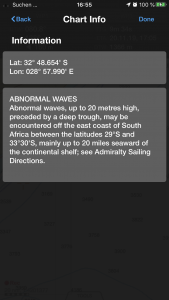
And it got nastier. I steered manually about 12 hours, when I had to give up. My third pair of pants and my second jacket was wet and I was a wreck mentally. To remind you – I was alone on the boat. Can you imagine how tricky it is to steer a boat in 45 knots of wind, through the rain and in heavy swell and at the same time change your wet cloth? You can’t let go of the rudder/steering. That was tough, and took a long time. I was scared to heave to (German: beiliegen), because when you heave to you cannot steer away from oncoming breaking waves. But when the wind went beyond the 50 knots mark, and I was totally worn out, I had no other choice, I got the sails down and was heaving to and I was drifting with the wind and the current. Luckily, the current was going the same direction I wanted to, and it was stronger than the wind so I was drifting in the right direction.
15.11.2019. 11:19
It was still blowing with 50 knots and sometimes waves crashed heavily against the hull and I was considering starting the motor to be able to steer away from oncoming dangerous breaking waves when I noticed that I could not turn the rudder. I saw that my jib sheet on the starboard side was hanging in the water. It has caught the rudder and I could not pull it up. What a nightmare – now being in 50 knots of wind in heavy swell and high breaking waves with an unmaneuverable boat. No way to clear the rudder in 50 kn of wind, in a boat rolling and hobby horsing wildly on the sea. I had to wait for the wind and swell to calm down. But it was fare away from doing it.
I was lying in my berth when all of a sudden a breaking wave hit the port side like a bomb. I never experienced such a blow. My shelves in the berth and the saloon were empty. Everything was spread on the floor. It was such a blow, that I was convinced, this would be the end of my cruise. A boat cannot withstand such a blow. I thought it was cracked, shattered, broken into pieces and would fall apart, so hard did I sense the impact. I was looking for my knife, ready to cut the belt that holds the life raft, and I jumped up the companionway to face the fact of having to abandon the ship..
Have you ever experienced a catastrophe? Can you imaging how much you can think in a split part of a second?
Because I knew of the danger in this area, some days ago I prepared the boat for the worst case. I packed two “grab bags”.
(for you landlubbers, a “grab bag” is an „emergency bag“ in which you put all those items that you need, in case you have to abandon the ship, launch the life raft, and climb in.)
It contains for instance, compass, emergency lights, electronic flares, bord books, passport, charts/maps, all gadgets like power packs, iPhone, iPad, board pc (which all contain my electronic maps/charts that I need for navigating), charging cables for all devices, 12 Volt USB adapters, a 12 V motorcycle batterie to power them, handheld GPS, EPIRB (Emergency Position Indicating Radio Beacon), mobile VHF sea radio, little batteries to power your handheld GPS and flashlights.
In addition you need fishing gear, clothes, blanket, some kitchen stuff like cutlery, can opener and at least one bowl, cup and plate, food and water (maybe for weeks!)
How much do you grab? That depends on how much time you have to switch from your boat to the life raft. In case of fire or an explosion (there is gas/Diesel on board) you would have little time, in case of flooding, you would have more time. Unless you have an explosion or fire, a boat does not sink within minutes. In fact if I had time enough, I would take along as much as I can. I would even take the dinghy, including the outboarder, along as well and would fill it up with all eatable stuff I have on board and every drinkable fluid like milk and juices and whatsoever.
Very important: the big water tight (pyrotechnics) box with flare signals, parachute rockets, smoke signals, water dying signals etc.
I have a list with all these items that I would put in the life raft, listed according to priority and the time I have.
Those two prepared grab bags and the box with the flare signals were lying in the starboard berth, ready to grab them any time if need be.
In my mind I have gone through these emergency procedures many times like I did when I was skydiving, thinking about what to do, if that parachute fails.
And now you can laugh at me:
In case I had time enough, I would even dismount one of my solar panels, take one of my spare controllers, some wires and little tools to jury rig a photovoltaic system. This would probably be the first life raft with a photo voltaic system ever. But that way, I would be able to power my GPS devices for ever, knowing my position any time. Who knows how long would I be drifting on the open sea until I get help?
Sorry – I got carried away – I was telling you about that wave that crashed against my hull.
All what I have mentioned above about the contents of the grab bags, went through my head within a few split parts of a second, while I was running up the companionway. I was scared to forget something vital.
I was really believing I would have to lauch the life raft, so hard was the blow.
After jumping on deck, I was surprised that my beloved Faule Haut was still floating, no cracks, no damage visible, the mast still standing. Amazing – what these boats can put up with. What a relief. What a joy. And if you had been on the boat, experiencing this blow, you would agree with me in saying, what a miracle. The blow almost knocked my Diesel jerry cans over board. But that was it. No damage. Almost unbelievable.
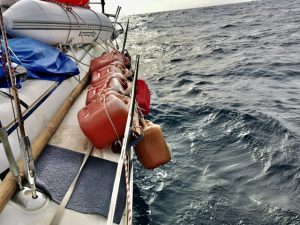
Then it got dark, still 40 to 50 kn of wind. This meant, I had to wait for the next day. No way to dive down to the rudder in the dark. A loooooong scary night ahead – drifting in up to 50 knots in heavy swell not being able to steer the boat away from breaking waves because of a blocked rudder. Will we get another blow like that again – or even one that is worse?
I didn’t sleep a single minute.
16.11.2919 09:00
The wind went down to 25 knots. What a relief. I decided not to wait any longer. It might even pick up again if I wait some more. I wrapped a rope around my waist and dived down. In fact, my jib sheet was wrapped around the rudder once and around the propeller several times (even though I had not used the motor). Six or seven dives and I got the rudder and prop cleared.
I got the sails up and started sailing again till I got stuck in the calms again on 17.11.2019 22:00.
18.11.2019
Got wind again. Hoisted the sails at 06:00 in the morning.
Checked my satellite phone and downloaded some SMS from Des with new updates about the forecast. Supposedly – it should look ok for the next 2 – 3 days. That’s good news. By then I should be about 110 nm before the South African coast. That’s the critical mark where the Agulhascurrent starts to be extremely fast and this area is to be avoided definitely in southerly winds. So in about three days the weather forecast will be of great importance to me. In case there are southerly winds to be expected, I would have to stop there 110 nm offshore, and heave to and wait for a change of wind direction. This could be even for a few days. I am hoping for the best.
19.11.2019
A beautifully morning and a calm night behind me. Too calm now, because I am on a sailboat and need wind. And there is none. Just about eight knots. But nevertheless I’m still moving. It’s because of the current I’m in. I’m making about three knots SOG (speed over ground) but no speed through the water. I’m inside the Agulhas current (not yet the point, where it is strongest). Waiting for wind to show up.
I’m watching the air pressure constantly. According to Des, rising pressure means southerly winds. And that is what I don’t want. When the wind is facing the Agulhas current, the state of the sea will turn hostile. The air pressure is going up now.
I started worrying, because was making too little speed, but then I got a message from Des, telling me I could relax, no dangerous weather for two to three days to be expected.
20.11.2019
I’m moving. Not fast – but better to move slow, than running in a gale. Air pressure is going down again.
21.11.2019
Same as yesterday. I am 270 nm east of my destination which is Richard’s Bay South Africa.
170 more nautical miles, and I will get to the critical point where the Angulhas Current will start to be at its strongest.
Short before reaching that point, I need to know the weather forecast. If there are southerly winds to be expected, I may not go further, but stop there and heave to until the weather changes.
My electronics charts on my iPad/iPhone, confirmed what I already knew from other sources – warnings about possible abnormal waves of up to 20 m hight.
Who needs these?
The said area between latitudes 29°S and 33°30’S is the stretch between Richard’s Bay and Port Elizabeth.
Never before have I watched the weather, air pressure and clouds so intensely as I am doing right now. I’m happy and lucky to get weather data every other day from this South African router Des, via satellite phone.
Now I hope it will be in my favor, so that I don’t have to heave to and be locked at that mentioned spot for days.
22.11.2019
I got stuck in the calms. Zero wind. The sea looks unreal. A week ago it was so hostile and about to wreck and destroy Faule Haut and now it’s flat and smooth as a baby‘s butt. Now again, my satellite phone helped me a lot. I got the weather forecast from Des, saying that there will be no wind for the next two days. Knowing this was important and I decided to start motoring towards Richards Bay. It would be to dangerous to wait here for wind. Because if it then comes from the south, the sea would turn to hell. I’m very close to the center of the Angulhas Currant, and if I motor now, I would cross it exactly while being in the calms. That’s ideal. That will be a lot of motoring hours (about 63) but I ain’t got no choice.
Together with my jerry cans, I got exactly the 220 liter Diesel on board to cover that distance (hopefully?!) That will be an expensive cruise, but if I want to be safe, I have to use the motor. .
ETA (Estimated Time of Arrival) Richard‘s Bay, South Africa: 24.11.2019 16:00.
Even being under motor, my boat speed is slow. I’m making less than 4.5 knots of speed through the water. It’s because my hull is full of barnacles again. I was gonna clean it at the port of Réunion but they had signs on each entrance warning about sharks being in the basin. Swimming not allowed.
I guess these barnacles reduce my speed way over one knot.
Speed over ground now is close to 6 knots because of the current. This ought to increase even more. I motored for 20 hours when enough wind showed up. I cut the motor and hoisted the sails. I sailed for about ten hours, when again I found myself in 40 kn of Wind and heavy swell. The autopilot quit working again. I took the sails down and started the motor again. This, the autopilot could handle only for a little while. I had to take over again. The wind got up to 50 knots, turned 60° and was facing straight towards my bow, coming from the south now, 210°.
Southerly wind, blowing right against the current, exactly that what I don’t want. Luckily, I only had 60 nm left to go to Richard’s Bay. So I thought during that short period of time the sea wouldn’t be able to build up these huge waves, I was scared of. But it was bad enough. I hadn’t really slept the last three days I was worn out up to the max. My tank was getting empty and I filled in the last 40 liters from my jerry cans. Not easy in 25 knots of wind and heavy swell, alone. Then the wind got over 35 knots and I had to steer manually again for about 6 hours through rough seas and big swell until. How I hate that!
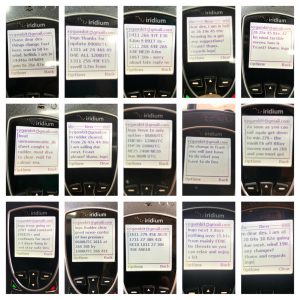
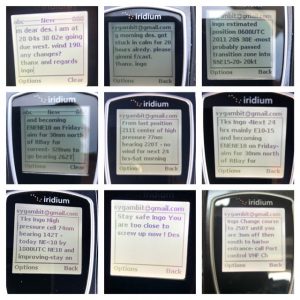
24.11.2019 06:00
the sun came up end the wind went below 30 knots and the autopilot took over.
12:30 Faule Haut is finally docked in Richard’ Bay South Africa. Skipper is looking forward to sleep. What a relieve.
Went to bed at five p.m.,
slept 15 hours when immigration knocked on my boat and woke me up for clearance next morning at
25.11.2019 08:00
Did the check in with immigration. Now I need to go to customs for clearance. Customs is 7 km away from here ( ! ) What a drag. Almost as bad as in Indonesia.
But – great joy – I just met Skipper Warren, the guy I know since we first met in Opua, New Zealand, and later at Mauritius again. He has been here for 14 days already. I would love to rest here for a few days or even week, but my appointment with crew in Cape Town makes it impossible.
Luckily, Warren has rented a car and is going to town in an hour. So I can join him and don’t have to use a taxi.

Schreibe einen Kommentar